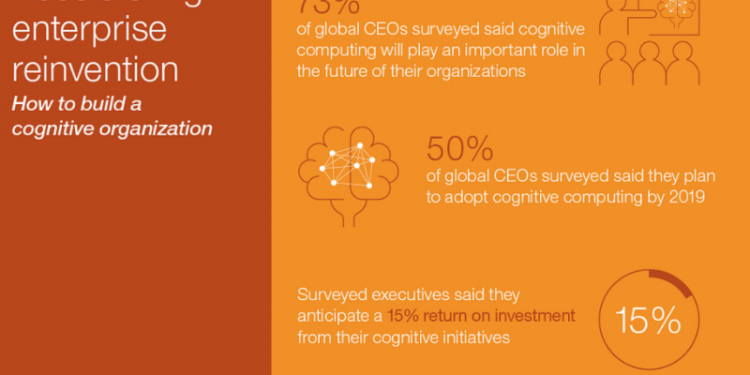The FINANCIAL — Cognitive computing has nearly endless possibilities to improve business processes and functions with 73 percent of surveyed CEOs in a recent IBM study citing it will play a key role in their organizations’ future and all executives in the study anticipating a 15 percent return on investment from their cognitive initiatives.
According to the new IBM Institute for Business Value (IBV) study, “Accelerating enterprise reinvention: how to build a cognitive organizations,” while investment in cognitive is expected to yield significant competitive advantages, surveyed executives are prioritizing its application in specific business functions including information technology, sales, information security, and innovation. The study is based on a survey from more than 6,000 executives across industries with further analysis from leaders of each business function to determine the organizational priorities for applying and adopting cognitive computing.
Cognitive computing is a next generation information system that can understand, reason, learn, and interact with humans in natural language. While traditional analytics can provide data-based insights, cognitive more easily turns these insights into actionable recommendations. A new IDC spending guide found global spending on cognitive platforms will climb from around USD 3 billion in 2016 to more than USD 31 billion by 20191. Concurrently, the IBV report found half of surveyed global CEOs plan to adopt cognitive computing by 2019.
This new study provides insight into how surveyed business leaders intend to prioritize cognitive investments within individual business functions to accelerate their business transformation. The study found the top three functional priorities to apply cognitive computing by surveyed CEOs include:
Information technology: to support faster, more efficient planning, development, and testing of enterprise software to enable greater agility and accelerated solution design.
Sales: to improve the efficiency of customer-facing services, expand customer account management capabilities, increase cross-sell and up-sell opportunities, and improve efficiency of lead management — all with richer contextual understanding.
Information security: enable faster, more reliable fraud detection or other activities within volumes of structured and unstructured data. By accelerating threat detection and reducing resolution time, this can save up to thousands of staff-time hours, freeing personnel to focus on more business-critical initiatives.
When it comes to accelerating enterprise innovation with cognitive, the IBV recommends businesses to:
Envision the future: outline a 18-to-24-month digital strategy for adopting cognitive with a limited set of initiatives that paves the way for smaller, more exploratory investments with finite objectives and time frames. Define enterprise or business unit reinvention case, KPIs, and targets. Apply a targeted operating model and governance that support this strategy.
Ideate: focus on thorough and periodic assessments in the market and with target users. Experiment and educate the rest of the enterprise on how cognitive capabilities are being used— such as the use of natural language processing or machine learning for large data analysis and insights. Create common use cases and applications, and design the basic standards and architectural considerations tailored to the organization. As the strategy progresses, assess market and user needs, define future experiences, end-to-end processes, and capabilities that cognitive can facilitate accordingly.
Incubate and scale: during the shift from planning and design to execution, apply cognitive to specific use cases, rapidly explore and prototype solutions to solve specific and measurable business challenges. Design and execute pilots with agility and limited risk to existing customers and operations. When these concepts are incubated, commercialized, and scaled, use a lean governance model to periodically review progress and value. Monitor the business case value realization and make adjustments, as necessary.






























Discussion about this post